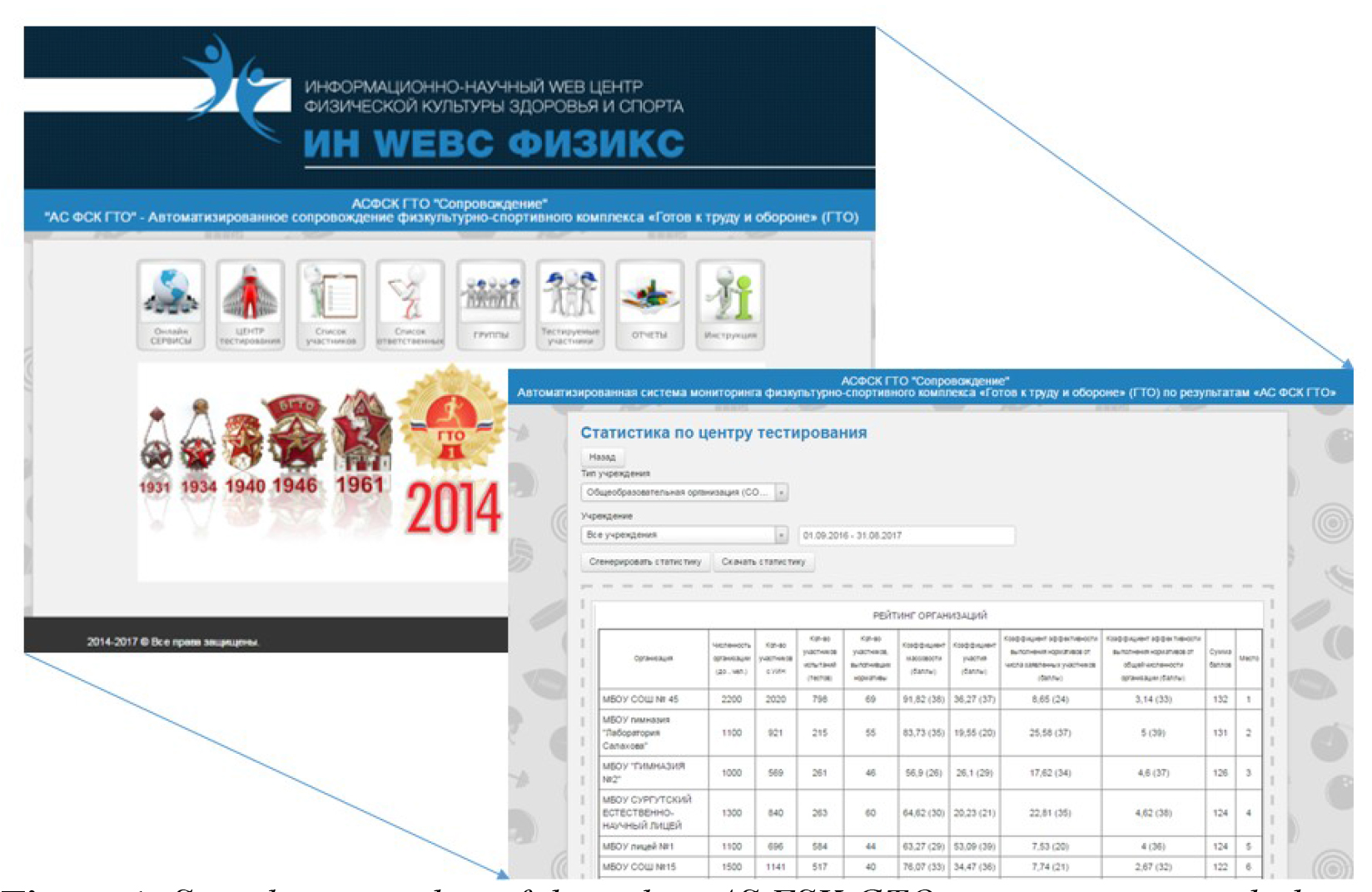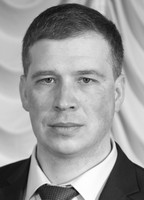Rating progress of education institutions in training for and organising GTO complex tests
Фотографии:
ˑ:
PhD, Associate Professor A.V. Fursov1
Dr.Hab., Professor N.I. Sinyavskiy1
1Surgut State Pedagogical University, Surgut
Keywords: RPCSC GTO, education institutions’ progress rating system, mass mobilisation ratio, participation ratio, efficiency ratio.
Background. The GTO Complex upon its implementation will provide a system of unified physical fitness standards for national educational establishments, the standards being applicable as students’ physical health and lifestyle indicators [3, 4]. One of the key missions of the GTO Complex is to “increase the share of population engaged in habitual physical culture and sports in the Russian Federation” [2, 5]. Successfully tested staff ratio to the total staff may be applied as an indicator of the corporate compliance of the GTO Complex test standards [1, 6]. Education institution’s progress in the GTO Complex implementation may be rated using the above successfully tested staff ratio to the total staff.
Objective of the study was to develop and substantiate a rating system to rank educational institutions by their progress in training students for and organising the GTO Complex tests.
Study results and discussion. In the course of the study we designed an online data processing system to obtain and process the municipal-level reports of the GTO Complex tests and uploaded the system as the AS FSK GTO at www.rosinwebc.ru.
The online data processing system offers a range of services to process GTO Complex test reports with the data being classified by the participating institutions and other parameters; monitor the group physical fitness rates tested by the GTO Complex tests; and rank the educational institutions by their progress in training students for and organising the GTO Complex tests.
The online data processing system offers effective tools for comparative analyses to profile the physical progress of any population groups at institutional, municipal, district and regional levels. The online data processing system makes it possible to monitor on a real-time basis operational efficiency of the lower-level units thereby giving the means for due performance control and/or timely adjustments to the GTO Complex implementation initiatives.
Progress of the participating education institutions in training students for and organising the GTO Complex tests is assessed by a set of the relative ratios. The education institutions’ progress ratios include the following: registered (with unique registration numbers) qualifiers; staff registration ratio; actual listed qualification ratio; and test success ratio versus the total registered participation. In addition, the online data processing system offers a set of profiling tools to profile progress of the GTO Complex implementation efforts.
The institutional progress rating procedure requires the following input data: registered qualifiers (registration on gto.ru website with unique registration numbers, URN); actually listed qualifiers for the GTO Complex tests; and the test success ratio.
Registered qualifiers show the degree of success of the GTO Complex promotion campaign and the awareness levels of the target group(s) on the GTO test registration (with unique registration numbers, URN) requirements. This rate is indicative of the quality of the prior promotion and institutional capacity building work to lure the would-be participants to the tests, conditional on the relevant physical fitness standards being met for qualification; due consent of the families or other legal representatives of the underage qualifiers; and permits from the relevant health bodies for participation in the GTO Complex tests.
Test success ratio of the GTO Complex tests shows the training quality of the voluntarily registered and listed qualifiers as verified by the GTO Complex tests.
Mass mobilisation ratio (MMR) is interpreted as indicative of the GTO Complex promotion campaign quality and may be calculated using the following formula:
MMR = (Registered participation/ total staff of the institution) x 100%
For example, if there are 1100 potential qualifiers for the GTO Complex tests in some school and 885 of them have voluntarily registered on gto.ru as a result of the GTO Complex promotion campaign, the mass mobilisation ratio (MMR) equals (885÷1100) × 100%= 80.45%.
Actually listed qualifiers ratio is also indicative of the GTO Complex promotion campaign quality and success and may be calculated using the following formula:
ALQR = (Actually listed qualifiers/ total staff of the institution) x 100%
Thus, if there are 1100 potential qualifiers for the GTO Complex tests in some school and 245 of them have actually listed for participation in the GTO Complex tests, the actually listed qualifiers ratio equals (245÷1100) × 100% = 22.27%.
Test success ratio to the listed qualifiers is characteristic of the actual fitness rates of the listed qualifiers for the GTO Complex tests calculated by the following formula:
TSR = (Successful qualifiers/ actually listed qualifiers) x 100%
For example, if there are 245 actually listed qualifiers for the GTO Complex tests in some group and 124 of them were successful in the tests being awarded with at least GTO Bronze Badges, the test success ratio equals (124÷245) × 100% = 50.61%. The same calculation may be applied to compute test success ratio versus total potential qualifiers (having the health permits) in some organisation.
Having the above GTO test ratios, we may now produce ranking lists for every test ratio, with the actual institutional ratios being converted to the relevant ranking points. This highest ratio obtained by the calculations is given the top score on the relevant scale, and then every ratio is converted to the score; and this is how each participating institution may be ranked.
If there are, for instance, 45 institutions competing in the GTO Complex tests, the most successful one (in some ratio) receives 45 points and Rank 1. The scoring points of the converted ratios are then summated, and the institutional total score is computed to give its place on the ranking list. This means that the higher is the original institutional ratio the higher is the specific rank, with Rank 1 being the topmost.
It should also be mentioned that the ranking points may be applied to generate graphical and matrix data reporting formats to visualise the institutional progress and success in the GTO Complex tests: see Figure 1.

Figure 1. Sample screenshot of the online AS FSK GTO service system with the institutional rankings.
Conclusion. The GTO Complex implementation progress of every educational institution may be rated and profiled by the proposed progress rating system to rank the most successful GTO Complex implementation practices so as to facilitate the decision-making on the further GTO Complex promotion and advancement initiatives to support the local mass physical culture and sports. The proposed method was successfully implemented at 60 educational establishments of Surgut.
References
- Zyurin E.A., Masyagina N.V., Nachinskaya C.V., Kalinkin L.A. Dopolnitelnoe obrazovanie kak instrument podgotovki kadrov dlya meropriyatiy kompleksa «Gotov k trudu i oborone» [Additional education as personnel training tool to implement "Ready for Labour and Defence" GTO complex initiatives]. Teoriya i praktika fiz. kultury, 2017, no. 2, pp. 36-38.
- Spirin V.K., Bagina V.A., Stepanov A.A. Normativnaya baza Vserossiyskogo fizkulturno-sportivnogo kompleksa v kachestve usloviya obosnovaniya tekhnologii podgotovki i organizatsii sdachi norm GTO [Regulatory framework of All-Russian Physical Culture and Sports Complex as a Condition of Substantiation of Technology of Preparation and Organization of Testing Against GTO ("Ready for Labour and Defense" Standards]. Fizicheskaya kultura: vospitanie, obrazovanie, trenirovka, 2015, no. 1, pp. 2-6.
- Fursov A.V., Sinyavskiy N.I., Tiunova T.A. Avtomatizirovanny servis AS FSK GTO v rabote uchitelya fizicheskoy kultury dlya otsenki gotovnosti uchashchikhsya shkol k vypolneniyu normativov kompleksa GTO [Automated service of ARPCSC GTO in PE teacher's work to assess pupils' fitness for GTO tests]. Mater. vseros. nauch.-prakt. konf., posvyashchennoy 85-letiyu udmurtskogo gosudarstvennogo universiteta "Sovershenstvovanie sistemy professionalnogo fizkulturnogo obrazovaniya i povyshenie kvalifikatsii spetsialistov po fizicheskoy kulture i sportu v ramkakh realizatsii federalnoy tselevoy programmy razvitiya obrazovaniya na 2016-2020 gody" [Proc. Rus. res.-pract. conf. dedicated to the 85th anniversary of Udmurt State University "Improvement of professional physical education system and professional development of physical education and sports specialists within federal target education development program for 2016-2020"]. 2016, pp. 246-250.
Corresponding author: physical_science@surgpu.ru
Abstract
Online data processing system was developed to obtain and process municipal-level reports of the GTO Complex tests. The online data processing system gives the means to: process GTO Complex test reports; classify them by institutions and other parameters; run a computerised monitoring of the population groups’ physical fitness for the GTO Complex tests; and rate progress of relevant education establishments in training students for and organising the GTO Complex tests. The institutional progress rating procedure requires the following input data: registered qualifiers (registered on gto.ru website with unique registration numbers, URN); actually listed qualifiers for the GTO Complex tests; and test success ratio. The education institutions’ progress ratios included the following: registered (with unique registration numbers) qualifiers; staff qualification ratio; actual listed qualification ratio; and test success ratio versus total registered participation.


